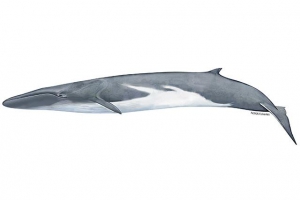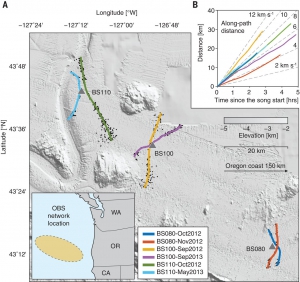Music of the ocean: The importance of fin whale vocalizations
By Adrianna Davis, SRC intern
The fin whale (Balaenoptera physalus) is the second-largest baleen whale (Figure 1). They can grow to be up to 85 feet in length and 80 tons. Their large size made the fin whales a target for commercial whalers in the mid-nineteenth century, ultimately reducing their population (NOAA Fisheries). Currently, fin whales are an endangered species with a population of approximately 100,000 individuals (Duna & Nábelek 2021).

Figure 1: Lateral illustration of a fin whale (Balaenoptera physalus) (Source: NOAA Fisheries)
Fin whales, like other cetaceans, have a unique vocalization pattern. They produce primarily 20-Hz and 40-Hz frequency downswept calls (Wiggins & Hildebrand 2020) that are short (<1 s) and repeat every 7 to 40 seconds for up to ten hours. These vocalizations are strong and can reach up to 189 dB (Duna & Nábelek 2021). The calls serve to establish and maintain contact with other whales and attract a mating partner (Wiggins & Hildebrand 2020).
Over the last several decades, the amount of noise in the ocean has increased. This increase is due to more frequent anthropogenic activity in the ocean, including ship traffic and ocean bottom studies. Seismic airgun array is one example of an ocean-bottom survey. These arrays are primarily used to find oil and gas in the subsea strata but are also used for research. The sound pulses produced from airguns are fired every 8-15 seconds for periods lasting longer than 24 hours. Many arrays last for months and are conducted over thousands of square kilometers (Dunlop et al. 2017).
Although the impact of anthropogenic sound sources on marine animals has been studied for more than 30 years, little is known about the severity at which it impacts them (Dunlop et al. 2017). The low-frequency bands utilized by marine mammals for communication, navigation, and foraging are dominated in many areas by the noise from traffic and ocean-bottom surveys (Castellote et al. 2012), so it is possible that they are negatively affected by the background noise in the ocean. Concerns arise about the repercussions for the conservation of the populations being impacted (Dunlop et al. 2017), especially if they are endangered, like the fin whale. One study was done in the Mediterranean Sea, which has the highest background noise levels of the ocean basins, as well as the Northeast Atlantic Ocean. The researchers found that fin whales were displaced and their singing behavior altered by anthropogenic noise sources. Although these effects were non-lethal, they are still concerning, as they increase the energetic costs of living for the whales (Castellote et al. 2012).
Fin whale songs may be used to complement seismic studies, such as airgun arrays. Fin whale vocalizations are strong and detectable over long distances; their source levels are comparable to noise from large ships. Ocean-bottom seismometer stations, used for monitoring earthquakes, often pick up fin whales’ vocalizations, as part of the energy from fin whale calls can transmit into the ground as a seismic wave (Figure 2) (Duna & Nábelek 2021).

Figure 2: (A) Spectrogram of an unfiltered fin whale song (B) Song section (C) Single whale call magnified from the song section (E) Travel path used to estimate the whale distance from the OBS (Source: Duna & Nábelek 2021)
In a study done by Duna and Nábelek, fin whale recordings were analyzed from three OBS network stations. Six songs, two from each station, were analyzed (Figure 3). The three sites’ results were consistent with observations made from previous seismic surveys, indicating that fin whale calls can potentially be used for seismic imaging; however, the fin whale results gave a lower resolution than the airgun surveys. This could be due to the narrower frequency band and lower dominant frequency of the calls. Other whales, such as sperm whales, may provide higher resolution results, as their vocalizations are higher-pitched (Duna & Nábelek 2021).

Figure 3: (A) Travel paths of whales in relation to the OBS network and seafloor bathymetry
(Source: Duna & Nábelek 2021)
There are many ways that anthropogenic activity has changed the oceanic ecosystem. The impacts of background noise due to ship traffic and seismic studies are poorly understood; however, they are likely to have a negative impact on marine species, especially those who rely on using vocalization methods, such as whales and other marine mammals. Using whale frequencies as a complement to ocean-bottom studies could decrease the demand for other more invasive techniques. They would also emphasize the importance of having those species in the ocean and could foster conservation efforts.
Works Cited
Castellote M., Clark C.W., & Lammers M.O. (2012). Acoustic and behavioural changes by fin whales (Balaenoptera physalus) in response to shipping and airgun noise. Biological Conservation, 147(1), 115-122. doi:10.1016/j.biocon.2011.12.021
Dunlop R.A., Noad M.J., McCauley R.D., Kniest E., Slade R., Paton D., & Cato D.H. (2017). The behavioural response of migrating humpback whales to a full seismic airgun array. Proceedings of the Royal Society B: Biological Sciences, 284(1869). doi:10.1098/rspb.2017.1901
Duna V.M., & Nábelek J.L. (2021). Seismic crustal imaging using fin whale songs. Science, 371(6530), 731-735. doi:10.1126/science.abf3962
NOAA Fisheries (n.d.) Fin whale (Balaenoptera physalus). Retrieved from https://www.fisheries.noaa.gov/species/fin-whale
Wiggins S.M., & Hildebrand J.A. (2020). Fin whale 40-Hz calling behavior studied with an acoustic tracking array. Marine Mammal Science, 36(3), 964-971, doi:10.1111/mms.12680





